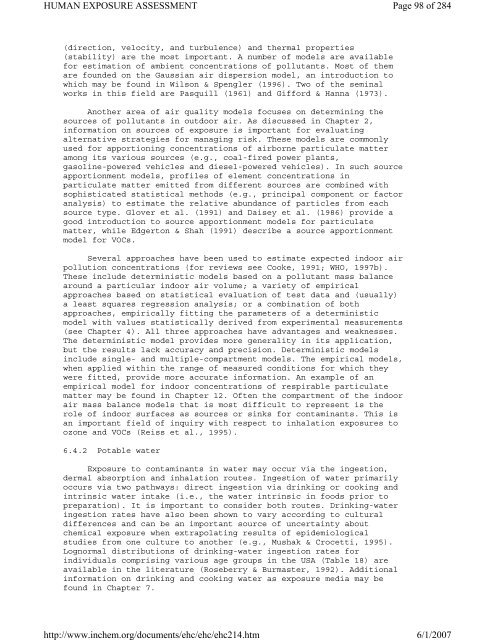Environmental Health Criteria 214
Environmental Health Criteria 214
Environmental Health Criteria 214
Create successful ePaper yourself
Turn your PDF publications into a flip-book with our unique Google optimized e-Paper software.
HUMAN EXPOSURE ASSESSMENT<br />
(direction, velocity, and turbulence) and thermal properties<br />
(stability) are the most important. A number of models are available<br />
for estimation of ambient concentrations of pollutants. Most of them<br />
are founded on the Gaussian air dispersion model, an introduction to<br />
which may be found in Wilson & Spengler (1996). Two of the seminal<br />
works in this field are Pasquill (1961) and Gifford & Hanna (1973).<br />
Another area of air quality models focuses on determining the<br />
sources of pollutants in outdoor air. As discussed in Chapter 2,<br />
information on sources of exposure is important for evaluating<br />
alternative strategies for managing risk. These models are commonly<br />
used for apportioning concentrations of airborne particulate matter<br />
among its various sources (e.g., coal-fired power plants,<br />
gasoline-powered vehicles and diesel-powered vehicles). In such source<br />
apportionment models, profiles of element concentrations in<br />
particulate matter emitted from different sources are combined with<br />
sophisticated statistical methods (e.g., principal component or factor<br />
analysis) to estimate the relative abundance of particles from each<br />
source type. Glover et al. (1991) and Daisey et al. (1986) provide a<br />
good introduction to source apportionment models for particulate<br />
matter, while Edgerton & Shah (1991) describe a source apportionment<br />
model for VOCs.<br />
Several approaches have been used to estimate expected indoor air<br />
pollution concentrations (for reviews see Cooke, 1991; WHO, 1997b).<br />
These include deterministic models based on a pollutant mass balance<br />
around a particular indoor air volume; a variety of empirical<br />
approaches based on statistical evaluation of test data and (usually)<br />
a least squares regression analysis; or a combination of both<br />
approaches, empirically fitting the parameters of a deterministic<br />
model with values statistically derived from experimental measurements<br />
(see Chapter 4). All three approaches have advantages and weaknesses.<br />
The deterministic model provides more generality in its application,<br />
but the results lack accuracy and precision. Deterministic models<br />
include single- and multiple-compartment models. The empirical models,<br />
when applied within the range of measured conditions for which they<br />
were fitted, provide more accurate information. An example of an<br />
empirical model for indoor concentrations of respirable particulate<br />
matter may be found in Chapter 12. Often the compartment of the indoor<br />
air mass balance models that is most difficult to represent is the<br />
role of indoor surfaces as sources or sinks for contaminants. This is<br />
an important field of inquiry with respect to inhalation exposures to<br />
ozone and VOCs (Reiss et al., 1995).<br />
6.4.2 Potable water<br />
Exposure to contaminants in water may occur via the ingestion,<br />
dermal absorption and inhalation routes. Ingestion of water primarily<br />
occurs via two pathways: direct ingestion via drinking or cooking and<br />
intrinsic water intake (i.e., the water intrinsic in foods prior to<br />
preparation). It is important to consider both routes. Drinking-water<br />
ingestion rates have also been shown to vary according to cultural<br />
differences and can be an important source of uncertainty about<br />
chemical exposure when extrapolating results of epidemiological<br />
studies from one culture to another (e.g., Mushak & Crocetti, 1995).<br />
Lognormal distributions of drinking-water ingestion rates for<br />
individuals comprising various age groups in the USA (Table 18) are<br />
available in the literature (Roseberry & Burmaster, 1992). Additional<br />
information on drinking and cooking water as exposure media may be<br />
found in Chapter 7.<br />
http://www.inchem.org/documents/ehc/ehc/ehc<strong>214</strong>.htm<br />
Page 98 of 284<br />
6/1/2007

















